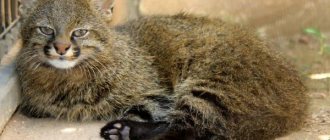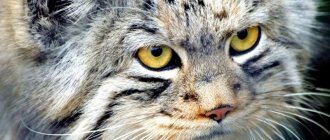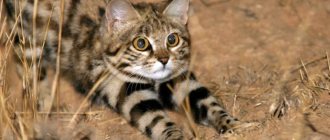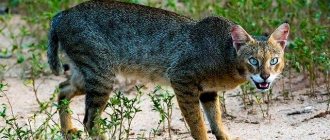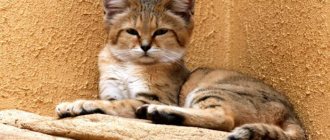The sand cat remains a mystery to modern people in many ways, despite the fact that this species was discovered more than a hundred years ago. The sand cat was destined to inhabit the most inaccessible corners of the planet, hardly compatible with life. In the merciless deserts of North Africa and Central Asia, these animals found their home.
Dune cat: description of the species
Developed hunter skills and the ability to competently distribute food and water resources allow representatives of the breed to populate the Arabian Peninsula to this day. The main danger for the Arabian cat is the person himself, who once saw in him an outlandish animal and is desperately trying to tame this animal.
Background
The time of the appearance of the dune cat and its further settlement are shrouded in mystery. Observations of this animal began relatively recently due to the difficult conditions in which sand cats live. What can we say, we owe the very discovery of this breed to chance.
The meeting of the general and two exotic cats marked the beginning of the study of this species
The sand cat, among all other representatives of the cat family, was lucky enough to be discovered twice. It was first discovered by the French general Jean Auguste Marguerite along with his expedition to the Sahara in 58 of the century before last.
The wild cat received its Latin name thanks to this historical meeting.
On the border between Libya and Algeria, a hiking group met two cats of unusual appearance, which could not help but attract the name. So they named this unprecedented beast in honor of the successful general - Felis margarita. The Latin designation itself was introduced by naturalist scientist Victor-Jean-François Loshomme.
There are several subspecies of the sand cat, and those that have already been discovered are far from the limit
Almost 70 years later, the dune cat again received attention, but this time from the Moscow researcher Sergei Ognev, who described it as a species. This time the sand cat was discovered in the Karakum and Kyzyl-Kum deserts. The confusion about the discoverers can be overcome if we take into account that the North African branch of the breed was discovered in the Sahara, and the Central Asian branch was discovered in the Kyzyl-Kum deserts.
Extraordinary desert cat
Don't be fooled by the cuteness quotient. This is the sand cat, or Felis margarita, a little-known species of desert cat. In the wild, it lives in places that are too hot and dry for any other cat - the deserts of Africa and Asia, including the Sahara. This is the only species of desert cat known to us. This cat itself is a tough nut to crack.
It also lives in the Arabian Desert, Iran and Pakistan, but despite such a wide distribution, the cat is not found in European descriptions until 1858. Victor Loche, a French soldier and naturalist exploring the Northern Sahara, first discovered the sand cat waiting patiently there for him to finally describe it.
Victor named it Felis margarita in honor of Jean August Margueritte. Although the name sounds half species and half cocktail, it was Marguerite who led the expedition during which Lohe "discovered" the cat, and was a prominent army general who served in Algeria. He died after being mortally wounded during a large cavalry charge at the Battle of Sedan during the Franco-Prussian War. Lohe sought to preserve his name for posterity, so he named the discovered cat in honor of Marguerite.
To some extent, the sand cat can be mistaken for a house cat, but there are differences between the two, such as a very wide head. In addition, the ears are much wider than those of a domestic cat, which means that the sand cat can hold them horizontally when hunting. These cats are slightly larger, growing ten centimeters longer than a domestic cat, give or take six centimeters.
As with length, they grow about 6 cm taller than a domestic cat. Their sandy-colored fur also distinguishes them from house cats, as do the pale stripes that can be seen on their paws and backs. Adding to their attractiveness is the white chin and underparts, as well as the pale red stripes that run down the cheeks from the eyes.
Another difference we know of that is hard to see in these photos is the fur between the cat's toes. You might think that the last thing a desert cat needs is too much fur, but it helps insulate their paws from the hot sand that cats use to chase prey. Fur is also needed to cover tracks.
The hollow structure that includes part of the middle and inner ear, the auditory bulla, is also larger than that of the domestic cat. This helps make their hearing sharper and allows cats to hear the vibrations of the sand. Finally, their mucous membrane (the membrane around the eyelids) is highlighted in black, giving the appearance that the cat has eyeliner.
Their habitat is so desolate that the sand cat sometimes has to wander for months without water. Instead, they survive on the water in their food, which is usually rodents, but they can also feed on birds, lizards and insects. They will not eat "human" food. Cats do not live in sand dunes, but prefer flat or gently sloping areas, retreating to their burrows when it gets too hot even for them.
Since they primarily feed on rodents, cats dig a lot. Sneaking close to the ground, they use their highly sensitive hearing to detect the sound of a rodent burrowing beneath them. When they hear something similar to this, they dig in that place to catch their prey.
Although they are not very social and only gather to mate, sand cats do not defend their territory. Many cats even share a hole with each other. One cat goes hunting, while the other stays in the hole and rests. When the first one returns, the other leaves.
Just like its obvious enemy (us!), the sand cat is not at the top of its own food chain. It is located before wolves and even sometimes snakes and large birds of prey. However, these cats are fearless creatures and are not afraid of humans when they come into contact with us.
Hunting for the sand cat is prohibited in only half of the countries in its range, although it is hoped that this law will soon spread throughout its range. Recently, they were even reintroduced into the wild in Israel, where the animals had previously been extirpated. The sand cat remains one of the least known but beautiful felines on the planet.
Subspecies
Today there are four subspecies of the sand cat, depending on their habitat:
Table 1. Subspecies of the sand cat
| Region | Subspecies |
| Sahara | Felis margarita margarita |
| Arabian Peninsula | Felis margarita harrisoni |
| Pakistan | Felis margarita scheffeli |
| Shore of the Caspian Sea | Felis margarita thinobia |
The subspecies differ from each other in coat color, without having any fundamental differences in physique or lifestyle.
The search for new possible habitats of the sand cat continues
Appearance of an Arabian cat
External data will be covered in detail in the tables below, but for now let’s dwell on the remarkable details of the dune cat. First of all, the tiny size of the predator attracts attention. In size, the sand cat is inferior even to many domestic breeds. The length of its body does not exceed a meter, and the tail occupies slightly less than half of the total size, reaching 30-40 cm.
The favorable location of the dune cat's ears prevents sand from becoming clogged in them and allows them to pick up the finest sounds.
Another characteristic feature of sand cats is their thick whiskers. Smoothly turning into large fluffy ears, they make the cat's face round and vaguely similar to the disk of the sun. It may seem that the animal's ears are larger than its head, and the head itself is slightly disproportionate for such a small, graceful body.
The sand cat's big eyes can let him down when he encounters an enemy.
The huge eyes attract attention, especially in those moments when the animal’s pupils are constricted. The sand cat knows this peculiarity of his, and also knows how it can give him away and even cost him his life. The fact is that all the disguise will go down the drain if the dune cat’s eyes glare from the refracted rays. Therefore, when he smells an enemy, he always presses himself to the ground and keeps his eyes closed.
“Mittens” on the paws prevent numerous burns, which are easy to get in the hot desert
The soles of the paws of dune cats are protected by a thick layer of thick and tough fur, which performs several useful functions:
- allows the cat not to leave traces behind;
- protects delicate paw pads from hot sand;
- creates support by fixing the paw in the sand so that the cat does not get stuck in the quicksand.
Table 2 . Sand cat exterior
| Part of the body | Details | Description |
| Head | ||
| Eyes | Large, have a yellowish tint. Slit-shaped, with yellow iris | |
| Nose | Small, pink-beige with a dark rim | |
| Ears | Wide and low to prevent sand from entering | |
| Scull | Wide and large, slightly flattened | |
| Limbs | ||
| Paws | Short, with dense fur protection, allowing you not to leave marks | |
| Feet | Covered with coarse fur | |
| Claws | Not very sharp, sharpened when climbing rocks | |
| Tail | Long, fluffy, occupies 40% of the entire body length |
By the way! Many people believe that the sand cat is the smallest representative of wild cats, but this is not so. The real record holders for miniature size are the black-footed wild cats that live in southern Africa. The maximum length of their body is half a meter, and the average weight is one and a half kilograms.
The very modest size is explained by the ability to fit in small holes, which the cat easily pulls out with strong paws
Table 3. Dimensions of the dune cat
| Part of the body | Length |
| Body | From 430 to 515 mm |
| Tail | From 276 to 290 mm |
| Back foot | From 116 to 127 mm |
| Ear | From 55 to 67 mm |
| Shoulders | From 260 to 290 mm |
Fur
The fur of a sand cat cannot be called very thick, lush or long. It has those qualities that are most practical in desert conditions: the desert cat is thick enough to prevent hypothermia, because at night the temperature in deserts sometimes drops below zero, and light enough to not overheat in the sultry heat under the scorching sun.
Not a single hunter is interested in the fur of the dune cat, which allows for better preservation of the species
Color
As already mentioned, the color of the dune cat depends on its habitat. There are representatives of the breed with fur of golden, light brown, and even gray shades. The rich palette of colors is explained by one main goal - to merge with the sand surface as unnoticeably as possible.
Light beige color is more common in nature
Camouflage is a necessity without which an animal cannot survive in the desert, in the vastness of which it is hardly possible to hide at any other time. The ability of the sand cat to move quickly and almost silently, without leaving any traces in the sand, makes hunting it extremely difficult.
Natural camouflage allows the sand cat to hide even from the watchful eye of a bird of prey
Add to these skills the complete color fusion of a sand cat with sand, and it becomes completely unsurprising why this animal remains in many ways inaccessible to researchers.
Following the trail of a sand cat is an impossible task
Despite the difference in colors, the color of the Arabian cat follows some general patterns:
- in the area of the chin and chest the fur is several shades lighter;
- the legs and head are decorated with a dark pattern;
- the tip of the tail is always black;
- in winter, the coat becomes duller in color with a gray undertone.
Character of a wild beast
Dune cats are nocturnal animals; only the subspecies from Pakistan can be active at dusk. When hunting, the animal can cover distances of up to 10 km. During the daytime, these cats sleep in the burrows of other animals, for example, foxes, porcupines, corsacs, and ground squirrels, and also dig out burrows of small rodents for overnight stays.
Important! This species hides all signs of its vital activity. The fur on the feet helps the animal not leave marks. In addition, the cat buries all food waste and never returns to the prey.
The sand cat is hunted by larger predators. These can be jackals, snakes, monitor lizards, as well as birds of prey.
Habitat of the sand cat
From the very name of the breed it is easy to guess that dune cats are regulars in the driest and most difficult to inhabit places on the planet, mainly European deserts. The strip along which representatives of the breed settled begins in North Africa (Algeria, Southern Morocco, Chad, Niger) and stretches across the entire Arabian Peninsula, reaching the countries of Central Asia: Uzbekistan, Pakistan, Turkmenistan and (less often) Kazakhstan. Sand cats were found in both Israel and Jordan, but in these regions they have now almost disappeared.
Places where dune cats previously took root are gradually decreasing
Life in captivity
A sand cat will never become completely domestic, but you can accustom it to the presence of people. In this case, you need to take not an adult cat, but a small kitten. You need to understand that the animal’s hunting instinct will remain, and the need for a nomadic lifestyle will also remain
This behavior of a pet should be changed with extreme caution, because a person can easily lose the pet’s trust
In captivity, this animal can give birth 2-3 times a year. Some people try to take advantage of this and replenish their capital, because the cost of one animal is 200 thousand rubles. With proper upbringing, the cat gets used to all family members.
Never buy animals from poachers, because by doing so you yourself become accomplices of crimes!
The necessary conditions
In order for the cat to get used to home conditions, you need to feed it by hand and talk to it. These pets should be kept in a stable, warm temperature and dry air. The room for keeping an animal is not very suitable, since in such conditions the animal will begin to experience stress and, as a result, a decrease in immunity.
The sand cat quickly learns human speech and reacts to its owner's intonation. She will quickly learn to use the tray. But you shouldn’t scold her for her faults. To prevent the animal from damaging property, you need to purchase a lot of toys for it. In a suitable climate, you can build an enclosure for a cat, equipping such a “dwelling” as follows:
- pour sand into it;
- make shelters;
- plant shrubs.
It would be a good idea to place a heated house in the enclosure. In captivity, the animal lives for 15 years, but this period can be extended under conditions close to natural.
Habitat
The sand cat lives in conditions in which other breeds could only survive, and even then with great difficulty. Even humans rarely visit the habitats of these animals, due to the difficulty of survival in deserts. Sand cats choose the most waterless areas, remaining alone with dunes and dry bushes.
Dune cats do not like looking for easy ways
It would be a big misconception to think that sand cats are found only in the sand. Sometimes representatives of the breed can be found among the rocks adjacent to deserts, in the gorges of which they make “homes” for themselves. Rocky valleys overgrown with shrubs are also inhabited by these animals. Dune cats also come out to the banks of reservoirs.
Sand cat lifestyle
The scarcity of desert lands for food encourages sand cats to constantly move. In the conditions of sand dunes stretching for hundreds of kilometers, the path is indicated by the prey, which the cat follows.
Permanent nomads, sand cats have learned to flexibly adapt to environmental conditions
From the merciless rays of the sun, the sand cat most often takes refuge in holes, usually fox holes. These animals will not refuse the burrows of porcupines and corsacs. Sand cats also dig holes themselves, but, as a rule, small ones in order to hide from danger. Digging is easy for these animals due to their short legs. These animals leave their shelters mainly at night, since hunting in the light of the sun is hardly a feasible task.
The presence of its own powerful paws does not in the least prevent the dune cat from settling into already prepared holes
By the way! Climbing out of the hole, the sand cat freezes for several minutes. This pause allows him to "scan" the nearby area without becoming visible to enemies. The animal performs the same thorough inspection on the way home after the hunt.
No sand cat will start hunting before he is sure of his safety.
The specificity of metabolic processes in the body of a sand cat brings it closer to a camel. These animals extract the main moisture from food and are also able to go without water for a long time. Cats manage to avoid large fluid losses by being active at night.
The Arabian cat more than makes up for its small size in agility. In one night, this beast can cover an area of ten square kilometers. Covering such large areas is easy for the sand cat thanks to its “signature” movement technique. While running, this animal keeps its body very close to the ground, while its head is lowered low to create the greatest streamlining of the body.
Night runs of several kilometers are commonplace for the Arabian cat
At first glance, this method does not seem successful, however, thanks to it, the nimble beast reaches speeds of up to 40 km/h. This method of movement also allows you to remain unnoticed from the outside, since the rapid movements of the paws merge with the general background of the sand.
A rare predator is able to spot a fast sand cat even in daylight
By the way! People who had contact with Arabian cats noted the animal’s developed intelligence. When the cat encountered lanterns aimed at him, he leaned toward the ground and closed his eyes, guessing in advance that the light reflections reflected in them could give him away.
Arabian cats really do not like to get caught in the rain, which is already rare in deserts, as well as in the territories adjacent to them. These animals prefer to wait out the rains in their shelters. The burrows in which sand cats hide reach one and a half meters in depth.
Dune cats welcome their comrades from neighboring territories.
Despite the fact that the “fiefdoms” of sand cats sometimes overlap, these animals live alone, looking for a mate only during the breeding season.
Hunting
In conditions of shortage of everything, dune cats could not help but learn masterly hunting. Usually these animals do not engage in direct confrontation, since they are sometimes smaller in size than their possible prey. Arabian cats prefer to ambush their prey completely unexpectedly, confusing it.
Unpretentiousness and thriftiness are two key skills that allow the dune cat to survive in the desert
Let us separately dwell on the fights between dune cats and snakes, for which this breed is famous. Arabian cats often emerge victorious in competitions even with such dangerous individuals as the horned viper, thanks to their tactics. Cats deftly stun their opponents with a blow to the head and quickly finish with a fatal bite to the neck.
Researchers were lucky to capture the moment of intense struggle
In winter, sand cats approach settlements, but they are not interested in poultry, which is typical for Amur forest cats. We also talk about the Amur subspecies Thus, some cats can enter the territories of other cats, which is perceived by representatives of the breed completely calmly. After hunting, the stranger returns to his native places.
Diet of the dune cat
The poverty of their native lands led to the extreme unpretentiousness of sand cats in their food. To briefly summarize their diet, these animals will eat anything that moves. The most traditional representatives of the desert fauna become the sand cats' lunch:
- rodents (gerbils, jerboas);
- spiders;
- lizards;
- small birds;
- hares;
- insects;
- snakes.
Desert predators do not disdain insects
Living in conditions of constant lack of food and drink has taught sand cats to competently handle food resources. These animals never leave uneaten prey, hiding it in a secluded place until the next meal. As a rule, food supplies are buried in the sand, and a developed sense of smell easily allows a wild cat to find the cache again.
Enemies
Animals that attempt to kill the Arabian cat include birds of prey, jackals, and monitor lizards. Don’t forget about the main enemy of many wild cats – humans. But it should be noted that poachers are hardly interested in the tedious tracking of dune cats in the hot desert.
The Arabian cat is a valuable commodity in many cat markets.
Arabian cats are most readily caught for sale. Purposeful sellers who want to sell an exotic pet at a higher price to an unreasonable buyer pose a real threat to this small species at the moment.
Arab countries have not yet had time to assess the damage caused to these rare representatives of cats
The main enemy of dune cats is overgrazing and ineffective management of pasture resources in general, which is characteristic of Arab countries, which leads to the destruction of the territories native to Arabian cats.
Lifestyle and behavior
Although the sand cat cannot jump or climb , it is excellent at digging in the ground. Thanks to this skill, he can create shallow burrows in which to cool off on very hot days. It may also sleep on its back outside the burrow to allow as much heat as possible to escape from the body.
Photo: Wallpaper Abyss
The animal is usually nocturnal , with the exception of the Pakistani subspecies, which is active at night in summer and at dawn and dusk in winter. Observers claim that when the sand cat encounters people at night, it closes its eyes to prevent people from seeing them glow in the dark, which could reveal the close presence of a feral cat. On the other hand, these wild cats, when discovered, show obvious submissiveness and lack of fear of humans.
Reproduction
Sand cats give birth once a year. Due to the fact that the habitats of sand cats are varied, they do not have a single time allotted for the mating season. It all depends on the specific region and climate. In North Africa, the breeding season lasts from January to April, but in Turkmenistan it starts only in April. In Pakistan, the rut occurs between September and October.
The breeding season does not coincide among furry inhabitants of different deserts
During the mating season, cats actively use their vocal cords (which they avoid on other days) and call females to them with cries. The opposite option is also possible - females also notify males of their readiness.
By the way! In honor of the unusual sounds made by these individuals, they are jokingly called “barking cats”, since these cries are more like the barking of small breeds of dogs.
Arabian cats bear kittens for two months. From 2 to 8 kittens can be born at a time. On average, two to three cubs are born. Males, as a rule, leave females after mating and do not form a single family. Dune cats raise their offspring on their own, fortunately, they grow very quickly.
Growing up a sand cat
Kittens are born blind in a hole already prepared by the mother cat. Their eyes open after two weeks and have a bluish tint, which gradually gives way to yellow. Surprisingly light (kittens weigh up to 30 g at first), sand kittens quickly gain weight within a month, feeding on their mother's milk.
Sand cat surrounded by blind kittens
By the second month of their life, kittens begin to eat solid food and leave their den, exploring the surroundings side by side with their parent, who teaches them to hunt. The kittens spend another three or four months under the supervision of their mother. At the age of six months, they already feel the strength to leave their parents and begin a completely independent life.
Almost from the first months, kittens keep their mother's company during the hunt.
Puberty occurs in different ways for sand cats. Some individuals mature as early as 9 months, some within a year, and others linger for up to 14 months.
By the way! Ordinary people who do not travel through deserts were able to see with their own eyes the cubs of the dune cat quite recently. Three years ago, the Israeli Zoological Center revealed to the world three kittens born to the sand cat Rotem, who had previously been the lone representative of this breed in an Israeli park.
Keeping leopard cats in captivity
Asian leopard cats are kept both indoors and outdoors in an enclosure. When kept outdoors, set up a cage measuring 1.5 x 3 x 1.5 m. The mesh size should be no more than 50 x 50 mm. The floor is preferably wooden. Sometimes they arrange areas with a mound of earth in which various herbal plants are planted. This is done to enrich the cat’s habitat and for the aesthetic component. To maintain cleanliness, it is most convenient to organize a restroom, which is a large tray. Be sure to install a shelter for the cat. This is a small wooden booth with a straw bedding inside. As for temperature, different types of Bengal cats tolerate frost differently. For southern subspecies, the booth should be heated, the optimal temperature is +20°C. The northern ones bring cold weather more calmly. Tree cuts and shelves are installed in the enclosure at different heights.
Upon reaching puberty, even domesticated animals become aggressive and uncontrollable. Especially in the absence of the opportunity to fulfill sexual instincts. Further castration or sterilization helps solve this problem. If dilution of ALC is not planned, surgery is indicated before puberty.
Maintaining an active lifestyle is very important for physical and social development, as well as reproductive health. These can be various games, toys, artificial mice
From time to time, several bunches of black grass or wheatgrass are picked up on the floor of the cat’s enclosure. The smell of freshly picked grass will diversify your pastime and make you activate your olfactory center. Another useful activity would be catching live food.
Walking kittens and adult cats is very important for full psycho-emotional and physical development. The domestic Asian leopard cat needs regular walks in the fresh air, where it receives ultraviolet light, feeds on meadow grass, and gets acquainted with new smells.
Population status
You can easily find a variety of statements regarding the number of dune cats. Information varies from tens of thousands to a couple of hundred copies. Such a significant scatter of data occurs because no one, not even scientists, has accurate calculations. Only now, thanks to the development of video equipment, are we gradually beginning to accumulate knowledge about these secretive animals.
It is hardly possible to count all sand cats
Zoological centers relatively recently took the sand cat under their protection and began to monitor its safety. The latest generally accepted figure, expressed by scientists after several years of observing sand cats, is 50 thousand adult individuals. However, these data, obtained more than twenty years ago, are clearly outdated and need to be rechecked.
Humanity realized quite late that the sand cat needed protection
At the moment, this animal is listed in the International Red Book as “close to vulnerable”. Catching representatives of the breed without a permit issued by some reserves is strictly prohibited. Of course, a strict ban does not exclude its periodic violations.
Zoos
Those few zoos that are lucky enough to keep the sand cat take great care of it. The fact that the Israeli sand cat gave birth to offspring made the workers of the zoological center happy, who did everything so that the last remaining Arabian cats could survive in Israel. There was even a report about this joyful event, which is given below.
Video - The long-awaited baby dune cat
As already mentioned, the sand cat is a rarity for all zoos in the world. According to the latest data, only 9 individuals of this species are distributed among different zoological centers. From time to time they can be transported so that dune cats have offspring. For example, Kalahari, the partner of the Israeli cat Rotem, came from Sweden.
Adults do not get along well with each other in captivity
Due to the fact that many representatives of the breed living in zoos come from the same pair, there is a high risk of inbreeding and the birth of non-viable offspring. There is evidence that half of the cubs born in captivity die due to the mother’s refusal to care for them.
Five years ago, two dune cats were transported from the Tallinn Menagerie (Estonia) to the Nikolaev Zoo. Nothing is known about the current condition of the animals.
Captivity
Sand cats are kept in many large zoos around the world, but they are very rarely seen in the home.
A dune cat is absolutely not suitable for a home, and especially an apartment. She needs a lot of open space. In captivity, he lives in spacious enclosures, which they try to arrange into a natural habitat. Dune cats raised in captivity get used to humans, they are less aggressive and timid, but it is dangerous to play with them. May severely scratch or bite. In life they follow their instincts and cannot be trained like domestic animals. Adult animals in captivity experience extreme stress, which often provokes neuroses and behavioral problems. Another unpleasant factor is their habit of marking territory, which, unlike that of domestic cats, is not corrected by castration.
What to feed a sand cat at home
The diet of a domestic dune cat should differ minimally from that in nature. Most of it should be small live rodents. In zoos, cats are given meat and meat products, sometimes eggs and poultry.
Is it possible to keep a dune cat at home?
The unusual colorful appearance of the Arabian cat and its apparent similarity to domestic breeds make it a desirable acquisition for many cat lovers. It seems that such a compact animal will live comfortably in a country house or even an apartment. But is it?
To date, there is not enough information on how well kittens get along with their owners
From all of the above, it is not difficult to conclude that the dune cat and captivity are two completely incompatible concepts. But, since they usually don’t ask a cat when they adopt it, without thinking about its usual lifestyle, let’s dwell on this point. It should be remembered that conditions that are normal for a domestic cat are a source of stress for a wild cat.
Content details
Think about it: is your home similar in climatic and tactile characteristics to the Sahara? If not, then you will have to take several steps towards this similarity.
- Low humidity should become a law, since this is the environment in which the sand cat has lived for centuries and to which it has managed to adapt. How the skin and health of cats will react to such a change is an open question.
- The air temperature should be constant regardless of the time of year. It is advisable to acquire a thermostat to carefully regulate possible changes.
- Since the dune cat’s immunity is not ready for a radical change in conditions, vaccination is the first place to start caring for your pet. However, even in the case of preventive vaccination, one cannot be sure that the animal will not catch some infection against which its body has never developed an immune response.
- Accustomed to exploring miles-long wastelands, the cat will be at a loss when he finds himself in a two-room apartment. The need for open spaces for animals is not an empty phrase. It will not be able to just give up its instincts associated with exploring the area and hiding food. Prepare in advance to find pieces of meat in the most unexpected places.
- Wild cats are much more active than their domesticated counterparts. Therefore, it would be desirable to have an interactive area in the house for your pet, on which he could climb. Otherwise, the pet will use any available furniture for its maneuvers.
Details of handling the sand cat are given below.
Useful tips for taming a dune cat
Buying a dune cat
When purchasing a supposed sand cat, you can never be sure of your purchase. Since there are no official nurseries that have permission to breed sand cats, the buyer always deals with underground organizations or individual sellers.
In this case, you cannot talk to the official breeder and find out the characteristics of the breed.
If you are persistent in purchasing this particular breed, it is recommended to pay attention to the kittens so that you can try to raise them.
By the way! Growing up, sand cats will still remember their roots and show their rebellious nature sooner or later. Therefore, it is not advisable for inexperienced potential owners to begin their acquaintance with cats with such a difficult breed to tame.
Price
The price for a dune cat starts from six thousand dollars and depends on the seller’s sense of proportion. On average, they can ask for two hundred thousand rubles for an exotic animal. It is possible to find cheaper options, but you need to be aware that the animals sold may not always be healthy to begin with. It is even more pointless to talk about whether they have any documents or certificates of vaccinations.
The inflated price of a dune cat is a natural state of affairs on the underground market
What does it eat?
The sand cat feeds on small game, which it hunts at night, which calls into question the possibility of keeping it at home. Its diet includes snakes, including horned vipers, sand mice, jerboas and other rodents, hares, birds, and insects. During the hunt, the predator first stuns the victim with a blow to the head, and then strikes with a bite to the neck.
In winter, cats live closer to human settlements, but do not hunt poultry. The predator lives far from bodies of water, so the bulk of the liquid enters its body through the food it eats. An animal can live without water for quite a long period of time.
Feeding
Among the dishes for the sand cat, since we are talking about a predator, meat dishes should dominate. Live food is preferred, but raw meat is also digestible. Sand cats and offal are readily eaten.
The main thing in feeding a wild cat is to monitor the sufficient amount of vitamins consumed
Taking vitamin supplements daily should become a habit. The owner should pay special attention to ensuring that the animal consumes a sufficient amount of calcium. On average, a sand cat should eat half a kilogram of meat per day.
Social structure
The sand cat is a typical solitary cat throughout the year. However, his habits change when mating time comes. Consequently, the frequency of occurrence of various forms of social interaction is very low. Social behavior for both sexes typically includes spitting, hissing, growling, pawing, sniffing, stalking, neck biting, and licking.
Dens are used by different individuals, but not at the same time. However, pairs may share the same burrows during the breeding season. After choosing a hole, the sand cat usually does not change its shelter during the day. It uses burrows that it digs itself, as well as dens left by other animals (such as a fox or porcupine), or it can enlarge the burrow of a captured gerbil or gopher.
Lifespan of a sand cat
If we consider the most successful cases, sand cats live 12-14 years in captivity. However, it is not worth comparing the conditions of an apartment and the conditions of safari parks. In the second case, the animals are surrounded by competent specialists who have a set of medications at hand for all occasions. Even these trained people lose several newborn kittens, let alone ordinary mortals.
An extended but boring life in captivity or a full life in your native desert?
Surrounded by love and care, but not receiving proper care, these animals can die unexpectedly and early for reasons that the owner had no idea about. Hopes for the competence of a veterinarian may not be justified, since documented knowledge on how to maintain the health of an Arabian cat simply does not exist. This once again confirms the incompatibility of representatives of the breed with life within four walls.
Diet
Like all other members of the family, these cats are predators. Under natural conditions, they eat everything they can catch. These can be jerboas or hares, snakes and large insects. These little ones manage to catch quite large prey, and the cat will never throw away the remains of the meal, but will bury it to return the next day. A sand cat at home retains its instincts, so you are guaranteed eggs under the pillow and bones behind the cushion of the sofa.
To save precious moisture and protect themselves from the heat, cats dig minks for themselves, but this is only a last resort. Most often they use the old shelters of foxes and other desert inhabitants.



